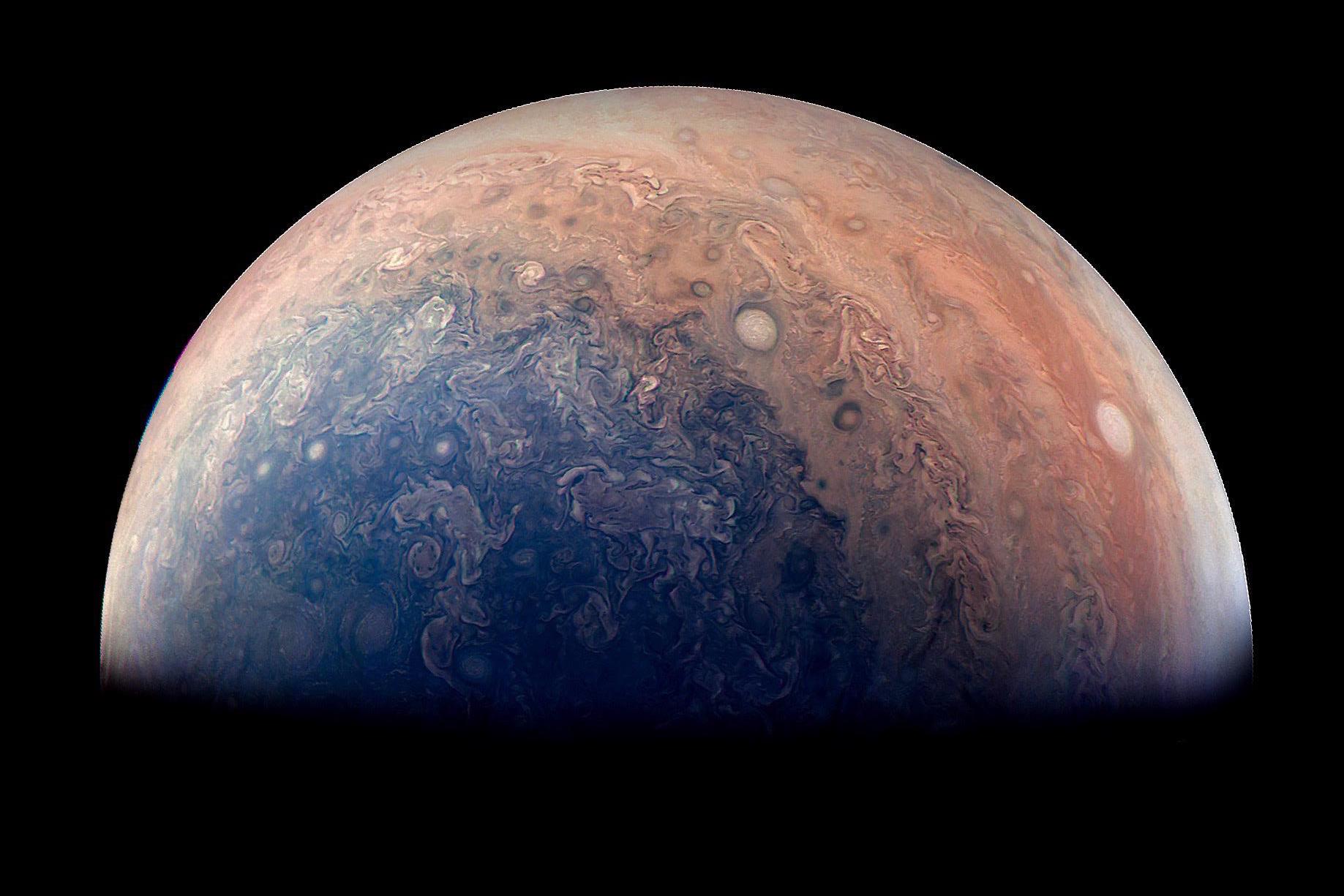
Newly-released, enhanced color view of Jupiter’s south pole from Juno as seen on Dec. 11, 2016. The image was taken from an altitude of about 32,400 miles (52,200 kilometers) above the planet’s beautiful cloud tops. Image Credit: NASA/JPL-Caltech/SwRI/MSSS/Gabriel Fiset
There has been a lot of attention given to the Cassini mission at Saturn lately, but meanwhile, NASA’s Juno probe also continues to be busy studying the largest planet in the Solar System, Jupiter. Juno is now revealing more of the giant planets’ secrets, and the first science resultshave now been published, which were presented last week at the European Geosicences Union meeting. As is common in planetary science, the new findings include significant surprises.
As it turns out, Jupiter’s interior seems to be rather different from what had been expected. Being a gas giant, Jupiter doesn’t have a surface as such below the atmosphere, it just gets progressively denser the farther down you go until you reach (as thought) a small, solid core.
“The whole inside of Jupiter is just working differently than our models expected,” said mission principal investigator Scott Bolton of the Southwest Research Institute in Texas.
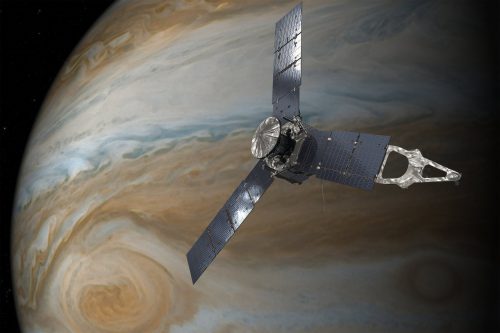
Artist’s conception of Juno orbiting Jupiter. Juno has already changed scientists’ views and understanding of the giant planet’s atmosphere and interior. Image Credit: NASA/JPL-Caltech
Previous models of Jupiter’s interior had been based on gravitational measurements of the planet, but the new findings appear to suggest something different. Jupiter’s interior, beneath the deep and turbulent atmosphere, was thought to be fairly uniform, with a shallow outer layer of liquid hydrogen overlying a thinner layer. In that thinner layer, it would “rain” helium. Farther down was a deeper layer of metallic hydrogen, and finally a smaller solid core, about 43,000 miles (70,000 kilometers) down. But now it seems, from Juno’s data, that those layers are not as uniform as previously thought.
“Jupiter’s molecular envelope is not uniform,” said Tristan Guillot of the University of the Cote d’Azur in France. “We assumed we could treat the envelope as global, but now, with the finer data, it appears less regular.”
Instead of a solid core, the data suggests that Jupiter has a more “fuzzy” core, which is dilutely mingled with the overlying metallic hydrogen layer. In short, Jupiter’s interior is more complex that first thought, which is an exciting find for scientists who want to understand how larger gas planets form and evolve.
The surprises also include the atmosphere as well. It’s been known for a long time that Jupiter has ammonia clouds, but Juno found that there is a dense, deep zone of ammonia gas around the equator, something not expected. Another parts of the atmosphere, ammonia is depleted, which is evidence for amonnia-based weather systems on Jupiter.
“We’ve known there’s a spike at the equator, but the new microwave data is showing that the spike goes way, way down into the abyss, 300 kilometres below the cloud,” said Leigh Fletcher of the University of Leicester, UK. “It suggests ammonia is being distributed by a weather system that penetrates much deeper than anyone expected.”
The new findings also extend beyond the planet itself as it were, with the discovery that Jupiter’s magnetic field is stronger and more irregular than first thought. The strength of the magnetic field was previously estimated to be about 5 gauss (compared to 0.25 to 0.65 gauss for Earth), but Juno found it to be possibly as high as 8-9 gauss. The dynamo which drives the magnetic field is now thought to be closer to the surface than expected.
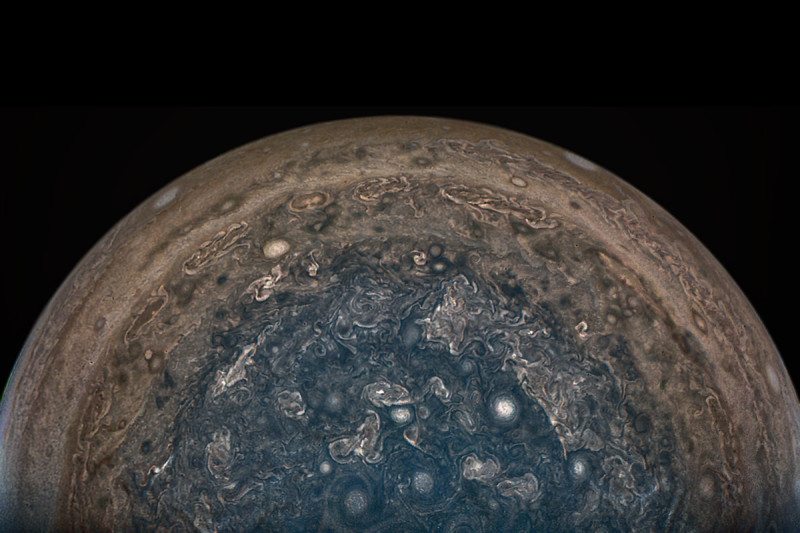
Another view of Jupiter’s south pole, in enhanced color, as seen by Juno during its fourth flyby on Feb. 2, 2017. Image Credit: NASA/JPL-Caltech/SwRI/MSSS/John Landino
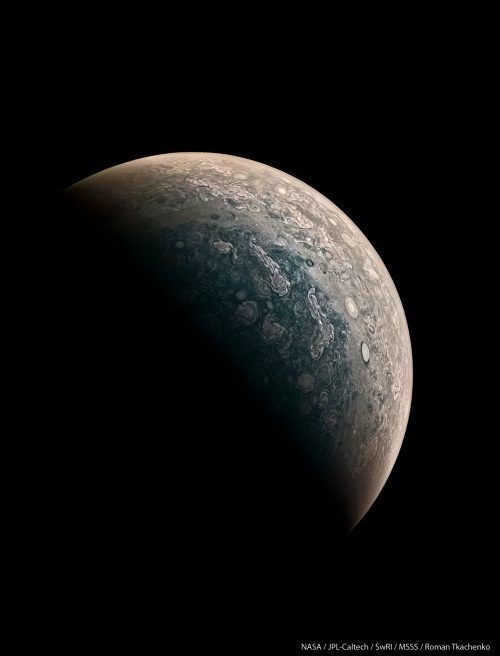
Jupiter’s north pole, as seen by Juno during its fifth flyby on March 27, 2017. Image Credit: NASA/JPL-Caltech/SwRI/MSSS/Roman Tkachenko
“I didn’t expect all the theories to be wrong, but there’s motion going on in the planet we did not anticipate,” Bolton said.
“Jupiter’s magnetic field is spatially complex, and there were deficits of up to 2 gauss elsewhere,” noted Connerney. “We may need many more orbits to resolve this.”
In March, Juno completed its fifth close flyby of Jupiter. Closest approach occurred on Monday, March 27, at 1:52 a.m. PDT (4:52 a.m. EDT, 8:52 UTC). All of the spacecraft’s science instruments were operating during the flyby; scientists now have even more data to go through from the mission so far.
As mentioned by Bolton last February, “This will be our fourth science pass – the fifth close flyby of Jupiter of the mission – and we are excited to see what new discoveries Juno will reveal. Every time we get near Jupiter’s cloud tops, we learn new insights that help us understand this amazing giant planet.”
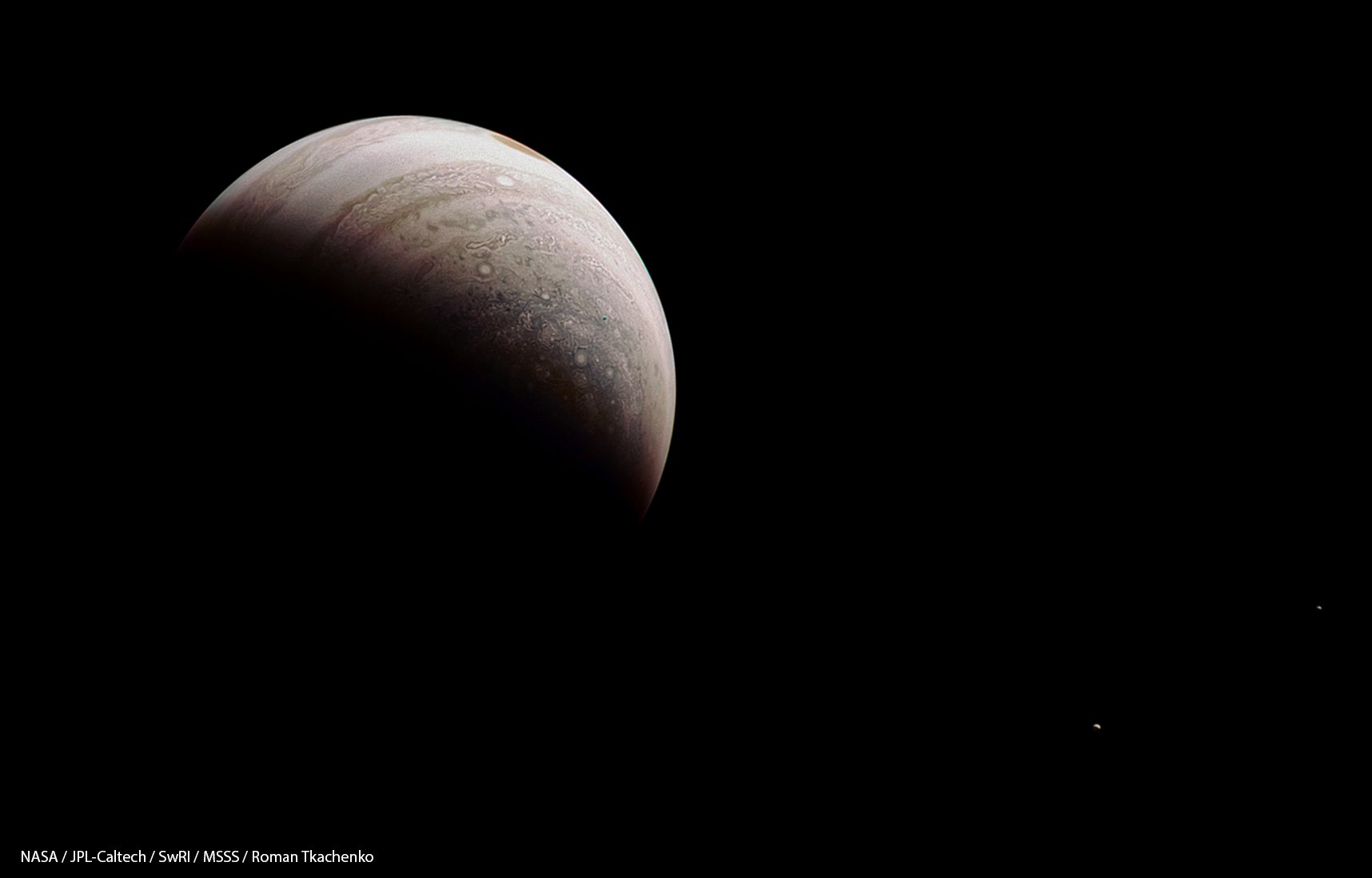
Crescent Jupiter, with two of its moons, Europa and Io, as seen by Juno during its fifth flyby on March 27, 2017. This is a view never possible from Earth. Image Credit: NASA/JPL-Caltech/SwRI/MSSS/Roman Tkachenko
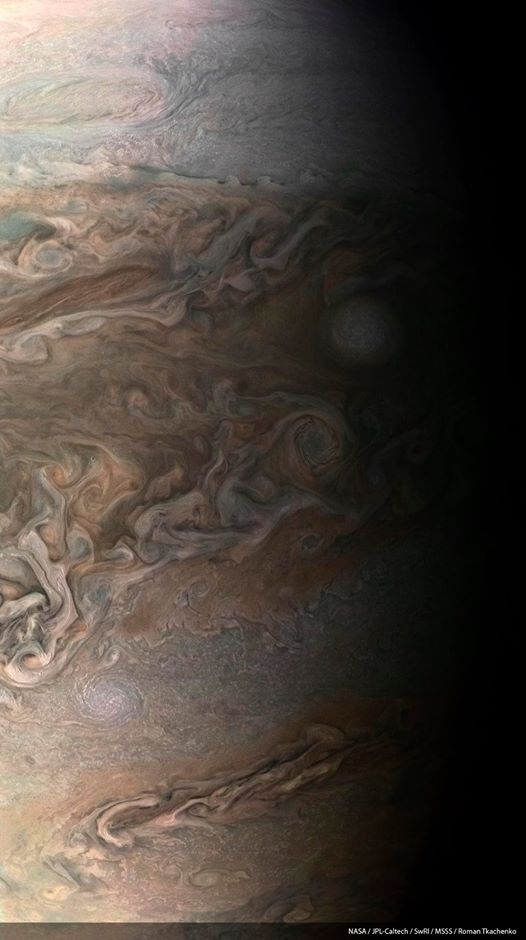
Enhanced color view from Juno’s fifth flyby on March 27, 2017. Image Credit: NASA/JPL-Caltech/SwRI/MSSS/Roman Tkachenko
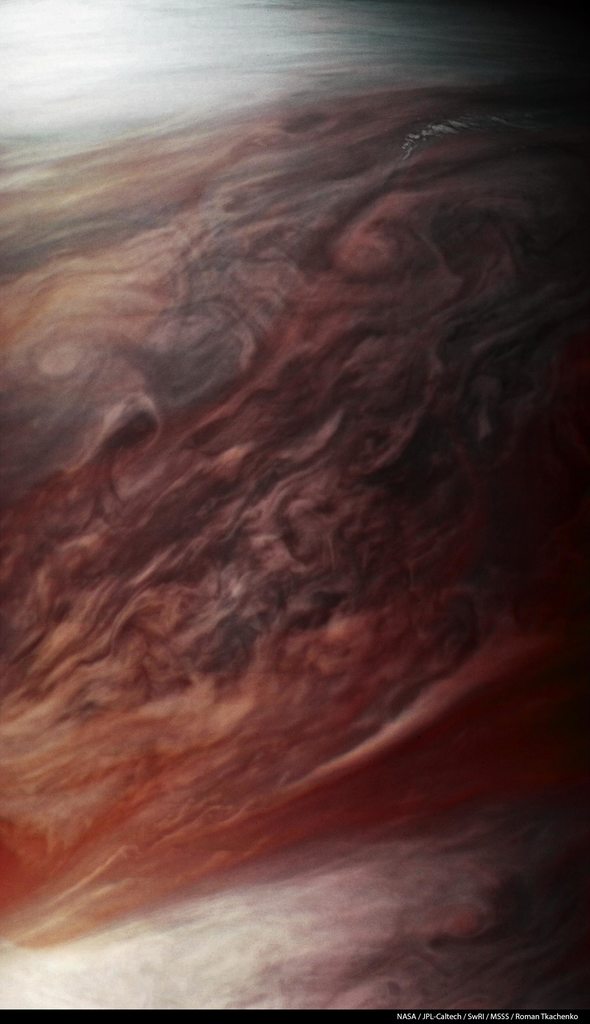
Another enhanced color view from Juno’s fifth flyby on March 27, 2017, from a distance of only 3,728 miles (6,000 kilometers). Image Credit: NASA/JPL-Caltech/SwRI/MSSS/Roman Tkachenko
Juno has also found previously unseen swirling cyclones in Jupiter’s atmosphere, similar to cyclones on Earth, but much larger.
As Glenn Orton of the Jet Propulsion Laboratory in Pasadena, California told New Scientist, “They’re the size of Earth, or maybe half an Earth. They’re probably composed of condensed ammonia.”
Juno has also seen other white ovals, in the cloud belts south of Jupiter’s equator. Their composition isn’t known for certain yet, but according to Alberto Adriani of the Institute for Space Astrophysics and Planetology in Rome, Italy, they likely contain ammonia and hydrazine. On Earth, hydrazine is used in rocket fuel.
As well as the atmosphere, Juno has also been studying Jupiter’s auroras. These are again similar to what we see on Earth, but more intense. The regions at the poles where they occur are composed mostly of methane and an ion containing three hydrogen atoms (H3+), at temperatures ranging from 500 to 950 kelvin.
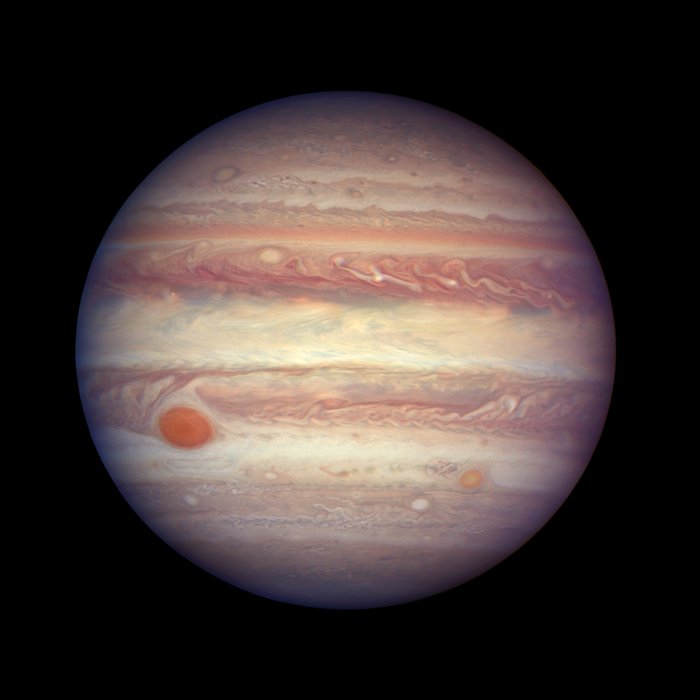
Jupiter as seen from Earth: stunning new image taken by the Hubble Space Telescope on April 3, 2017. Photo Credit: NASA/ESA/A. Simon (GSFC)
And of course there are the images. Juno has been taking the highest-resolution images of Jupiter during its mission, including of the polar regions. They can often look like works of art – the clouds, storms and eddies in the atmosphere appearing like they were painted by a cosmic hand. Jupiter’s visible atmosphere is extremely turbulent, but that just adds to its beauty. The camera itself has also proven to be more resilient than anticipated, despite being hit by Jupiter’s radiation on an on-going basis.
“The good news is radiation damage so far is almost negligible, so it will operate for many years,” Orton said.
Last February, it was announced that Juno would remain in the same orbit for the remainder of its mission, due to a problem with the main engine. This doesn’t adversely affect the health of the spacecraft, but it means that Juno won’t be able to orbit even closer to Jupiter. The orbit it’s in right now is an elongated 56-day orbit. Juno was supposed to then switch to a closer, 14-day orbit, but the engine problem meant that the new orbit might be less than desirable, so it was decided by the mission team that the spacecraft would remain in the same orbit it is in now, for the rest of the mission. That won’t affect the science obtained too much however. It also means that the spacecraft will be subjected to less radiation overall, another plus.
“Another key advantage of the longer orbit is that Juno will spend less time within the strong radiation belts on each orbit,” said Bolton. “This is significant because radiation has been the main life-limiting factor for Juno.”
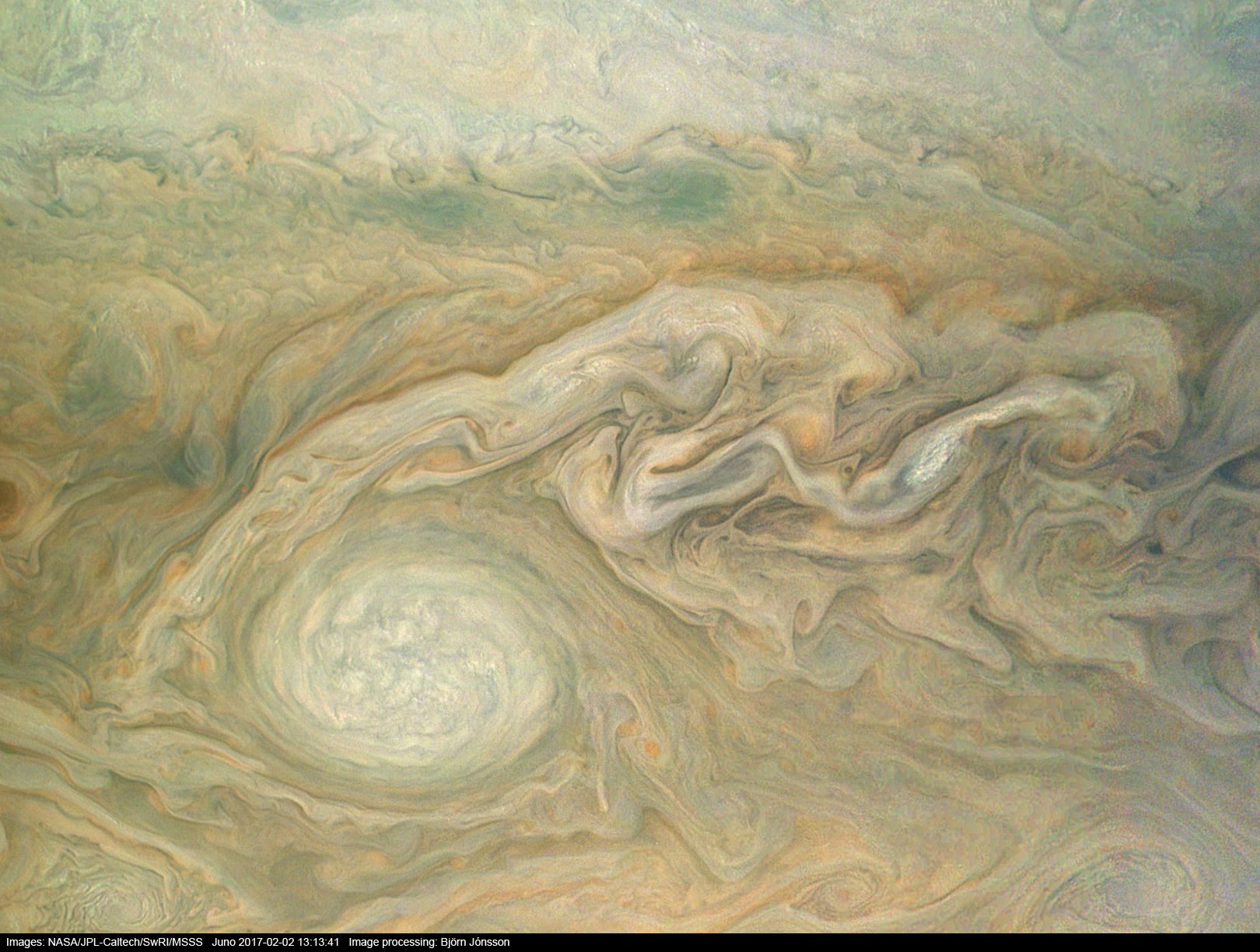
Intricate cloud formations in Jupiter’s atmosphere, from Juno’s fourth flyby on Feb. 2, 2017. Image Credit: NASA/JPL-Caltech/SwRI/MSSS/Björn Jónsson
“Juno is providing spectacular results, and we are rewriting our ideas of how giant planets work,” said Bolton. “The science will be just as spectacular as with our original plan.”
Apart from Juno, the Hubble Space Telescope also recently took some breathtaking new images of Jupiter, showing the well-known distinctive dark bands and the Great Red Spot. Hubble is able to see features as small as 80 miles (130 kilometers) across in Jupiter’s atmosphere.
Juno’s next closest approach to Jupiter, the sixth flyby, will be on May 19, which will include flying over the Great Red Spot, the most well-known feature on Jupiter. This will be a chance to study the massive and long-lived storm in more detail than ever before.
“It means that for the first time, we can go down deep and find out what’s going on underneath,” Fletcher said.
More information about the Juno mission is available on its NASA website.
Quelle: AS
---
Update: 19.05.2017
.
NASA's Juno spacecraft will make its fifth science flyby over Jupiter's mysterious cloud tops on Thursday, May 18, at 11 p.m. PDT (Friday, May 19, 2 a.m. EDT and 6:00 UTC). At the time of perijove (defined as the point in Juno’s orbit when it is closest to the planet's center), the spacecraft will have logged 63.5 million miles (102 million kilometers) in Jupiter’s orbit and will be about 2,200 miles (3,500 kilometers) above the planet's cloud tops.
Juno launched on Aug. 5, 2011, from Cape Canaveral, Florida, and arrived in orbit around Jupiter on July 4, 2016. During its mission of exploration, Juno soars low over the planet's cloud tops -- as close as about 2,100 miles (3,400 kilometers) During these flybys, Juno is probing beneath the obscuring cloud cover of Jupiter and studying its auroras to learn more about the planet's origins, structure, atmosphere and magnetosphere.
NASA's Jet Propulsion Laboratory, Pasadena, California, manages the Juno mission for the principal investigator, Scott Bolton, of Southwest Research Institute in San Antonio. The Juno mission is part of the New Frontiers Program managed by NASA's Marshall Space Flight Center in Huntsville, Alabama, for the Science Mission Directorate. Lockheed Martin Space Systems, Denver, built the spacecraft. JPL is a division of Caltech in Pasadena, California.
Quelle: NASA
---
Update: 26.05.2017
.
Monstrous cyclones churning over Jupiter's poles

Monstrous cyclones are churning over Jupiter's poles, until now a largely unexplored region that is more turbulent than scientists expected.
NASA's Juno spacecraft spotted the chaotic weather at the top and bottom of Jupiter once it began skimming the cloud tops last year, surprising researchers who assumed the giant gas planet would be relatively boring and uniform down low.
"What we're finding is anything but that is the truth. It's very different, very complex," Juno's chief scientist Scott Bolton of the Southwest Research Institute said Thursday.
With dozens of cyclones hundreds of miles across — alongside unidentifiable weather systems stretching thousands of miles — the poles look nothing like Jupiter's equatorial region, instantly recognizable by its stripes and Great Red Spot, a raging hurricane-like storm.
"That's the Jupiter we've all known and grown to love," Bolton said. "And when you look from the pole, it looks totally different ... I don't think anybody would have guessed this is Jupiter."
He calls these first major findings — published Thursday — "Earth-shattering. Or should I say, Jupiter-shattering."
Turning counter-clockwise in the northern hemisphere just like on Earth, the cyclones are clearly clustered near the poles. The diameters of some of these confirmed cyclones stretch up to 1,700 miles (2,800 kilometers). Even bigger, though shapeless weather systems are present in both polar regions. At the same time, the two poles don't really resemble each other, which is puzzling, according to Bolton.
Scientists are eager to see, over time, whether these super cyclones are stable or dynamic. "Are they going to stay the same way for years and years like the Great Red Spot ... Of course, only time will tell," Bolton said.
Just as intriguing will be how fast these super cyclones are moving.
Launched in 2011 and orbiting Jupiter since last summer, Juno is providing the best close-up views ever of our solar system's largest planet, peering beneath the clouds for a true portrait. It's made five close passes over Jupiter so far for science collection, the most recent last week; they occur about every two months given Juno's extremely oblong orbit. The next one will be in July, with investigators targeting the Great Red Spot.
Juno is moving so fast during these chummy encounters that it takes only two hours to get from the north pole to the south.
Besides polar cyclones, Juno has spotted white ice caps on Jupiter — frozen bits of ammonia and water. Bolton refers to them as Jovian snowfall — or maybe hail.
Juno also has detected an overwhelming abundance of ammonia deep down in Jupiter's atmosphere, and a surprisingly strong magnetic field in places — roughly 10 times greater than Earth's. It's also led scientists to believe Jupiter may have a "fuzzy" core — as Bolton puts it — big but partially dissolved.
Then there are the eerie sounds of plasma waves at Jupiter — "nature's music," according to Bolton. During the teleconference, he played two minutes of the spacecraft's recording from February, adjusted for the human ear and full of percussion sounds as well as high-pitched beeps and squeals, and even flute-like notes.
Results were published in Science and Geophysical Research Letters.
Jupiter's poles appear dramatically different from neighboring Saturn's, according to the scientists, with nothing like the hexagon-shaped cloud system over Saturn's north pole.
Researchers hope to compare Juno's observations with those of NASA's Cassini spacecraft, in its final months orbiting Saturn.
Juno's findings are "really going to force us to rethink not only how Jupiter works, but how do we explore Saturn, Uranus and Neptune," Bolton said.
Quelle: abc
+++

The first close-up observations from Nasa’s Juno spacecraft have captured towering clouds, swirling cyclones and dramatic flows of ammonia that drive giant weather systems on the largest planet in the solar system.
The $1.1bn probe swung into orbit around Jupiter in July last year on a mission to peer through the thick clouds that shroud the planet and learn how the alien world, and ultimately all of the planets in the solar system, formed around the nascent sun 4.5bn years ago.
“We were all jumping up and down with excitement when the images came down,” said Fran Bagenal, a planetary space physicist at the University of Colorado, who joined the Juno mission more than a decade ago. “You’ve got to be patient, but the rewards are fantastic.”

The spacecraft survived an almost six-year, 2.8bn km voyage across the depths of space to reach its destination, where it ducked beneath Jupiter’s intense radiation belts, turned on its suite of instruments, and swept into an orbit that loops over the planet’s north and south poles.
From 5,000km above the brown-orange blanket that covers the planet, Juno’s camera snapped pictures of tall, white storm clouds standing high above the rest. Some were so high, they stood out even on the nightside of the planet, betrayed by the feeble light of the sun glinting off them.
Yet more images revealed flashes of lightning that illuminate the Jovian sky. “The weather is dramatic,” said Bagenal. “What we thought we knew about Jupiter, we underestimated. It’s more variable, there are more features, there is much more detail the closer you look.”
Described as a “planet on steroids” by Scott Bolton, the mission’s principal investigator at the Southwest Research Institute in San Antonio, Jupiter is an enormous gas giant made from hydrogen and helium. Compared with Jupiter and the sun, the rest of the solar system is an afterthought. All of the other planets, the asteroids and comets, would fit within Jupiter, a planet 11 times wider than Earth.
Writing in two papers in the journal Science today, the Juno team describe fresh images and measurements of the planet’s atmosphere, magnetic field and the brilliant non-stop lightshows that constitute the aurorae at Jupiter’s poles.

Its sensors peering down as it swooped around the planet, Juno spotted chaotic scenes with bright oval-shaped features swirling in the clouds. Time-lapse images revealed them to be enormous cyclones, rotating counter-clockwise in the northern hemisphere. The storms reached up to 1,400km wide, more than ten times the size of the largest cyclones on Earth. Deep inside the atmosphere, the scientists found evidence for what they called an “equatorial plume” – a massive and unexpected overturning of gas driven by a steady upward stream of ammonia from around the planet’s equator. It seems to mirror the Hadley cell convection currents on Earth, where warm air rises at the equator and falls again about 30 degrees to the north and south. But “It looks like a band that goes all the way round the middle of Jupiter,” said Bagenal. The question is where does it go down?”
Another instrument on Juno measured the magnetic field of the planet and found it to be twice as strong as scientists expected, at about ten times greater than the field that surrounds Earth. During observations of the planet’s intense aurorae, Juno detected streams of electrons hurtling down into Jupiter’s upper atmosphere, where they potentially power the spectacular light shows.
Over the coming months, Juno will build up an unprecedented map of the planet’s interior before its instruments succumb to the harsh radiation and the spacecraft plunges into the clouds at the end of its mission. Along for the ride are three Lego crew members: the Roman god Jupiter, his wife Juno, and a telescope-wielding Galileo, who discovered four of Jupiter’s 53 moons.
One mystery scientists are keen to clear up is whether Jupiter has a solid core. With more data from the orbiting Juno, it is a puzzle they hope to answer. “We’re having to put together this 3D puzzle,” Bagenal said. “And surprise, surprise, it isn’t like Earth.”
Quelle: theguardian
---
Update: 28.05.2017
.
A WHOLE NEW JUPITER: FIRST SCIENCE RESULTS FROM NASA’S JUNO MISSION

Early science results from NASA’s Juno mission to Jupiter portray the largest planet in our solar system as a complex, gigantic, turbulent world.
Credit: NASA/JPL-CalTech/USGS.
WASHINGTON, DC — Early science results from NASA’s Juno mission to Jupiter portray the largest planet in our solar system as a complex, gigantic, turbulent world, with Earth-sized polar cyclones, plunging storm systems that travel deep into the heart of the gas giant, and a mammoth, lumpy magnetic field that may indicate it was generated closer to the planet’s surface than previously thought.
“We are excited to share these early discoveries, which help us better understand what makes Jupiter so fascinating,” said Diane Brown, Juno program executive at NASA Headquarters in Washington, D.C. “It was a long trip to get to Jupiter, but these first results already demonstrate it was well worth the journey.”
Juno launched on Aug. 5, 2011, entering Jupiter’s orbit on July 4, 2016. The findings from the first data-collection pass, which flew within about 2,600 miles (4,200 kilometers) of Jupiter’s swirling cloud tops on Aug. 27, are being published this week in two papers in the journal Science, as well as a 44-paper special collection in Geophysical Research Letters, a journal of the American Geophysical Union.
“We knew, going in, that Jupiter would throw us some curves,” said Scott Bolton, Juno principal investigator from the Southwest Research Institute in San Antonio. “But now that we are here we are finding that Jupiter can throw the heat, as well as knuckleballs and sliders. There is so much going on here that we didn’t expect that we have had to take a step back and begin to rethink of this as a whole new Jupiter.”
Among the findings that challenge assumptions are those provided by Juno’s imager, JunoCam. The images show both of Jupiter’s poles are covered in Earth-sized swirling storms that are densely clustered and rubbing together.
“We’re puzzled as to how they could be formed, how stable the configuration is, and why Jupiter’s north pole doesn’t look like the south pole,” said Bolton. “We’re questioning whether this is a dynamic system, and are we seeing just one stage, and over the next year, we’re going to watch it disappear, or is this a stable configuration and these storms are circulating around one another?”
Another surprise comes from Juno’s Microwave Radiometer (MWR), which samples the thermal microwave radiation from Jupiter’s atmosphere, from the top of the ammonia clouds to deep within its atmosphere. The MWR data indicates that Jupiter’s iconic belts and zones are mysterious, with the belt near the equator penetrating all the way down, while the belts and zones at other latitudes seem to evolve to other structures. The data suggest the ammonia is quite variable and co

